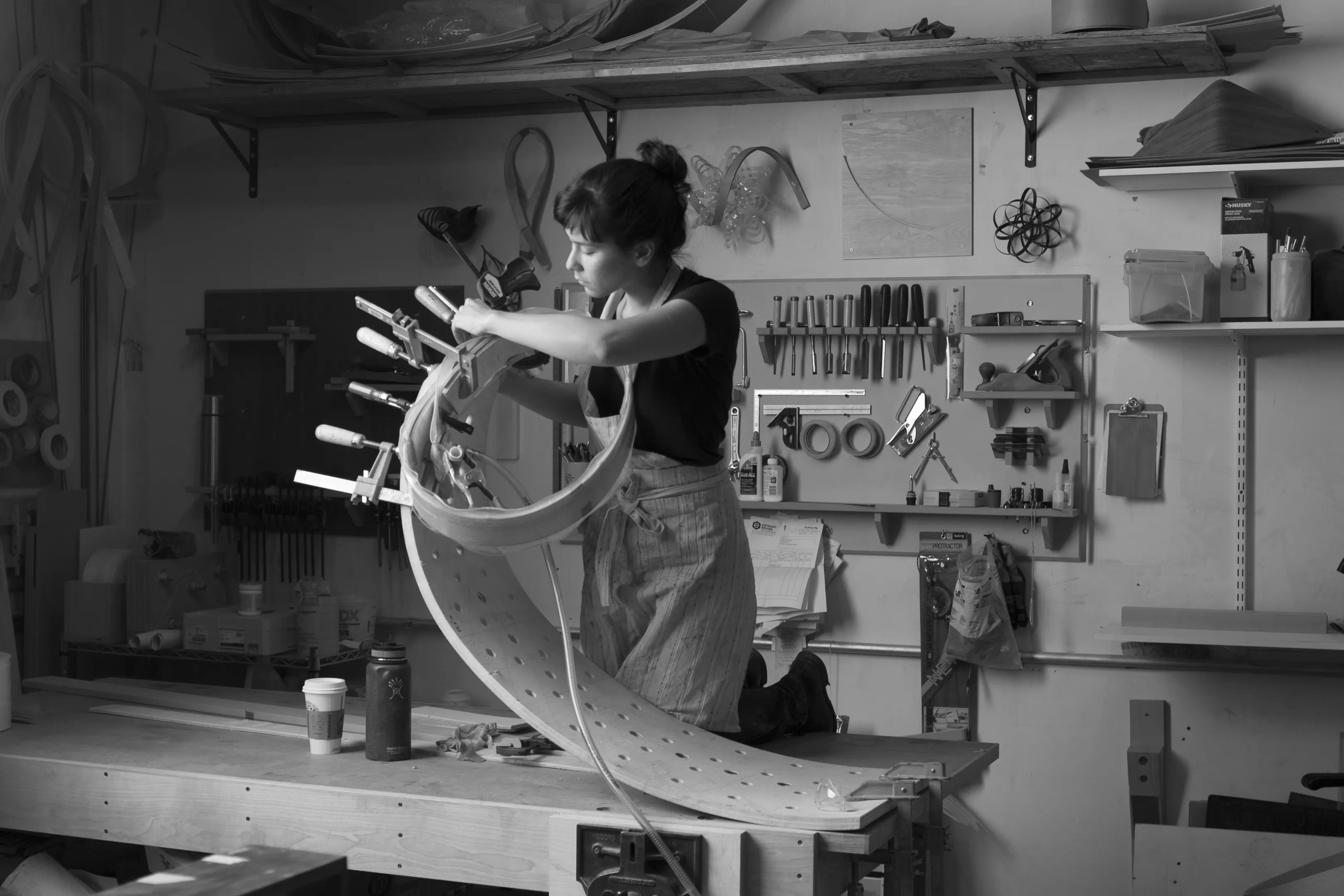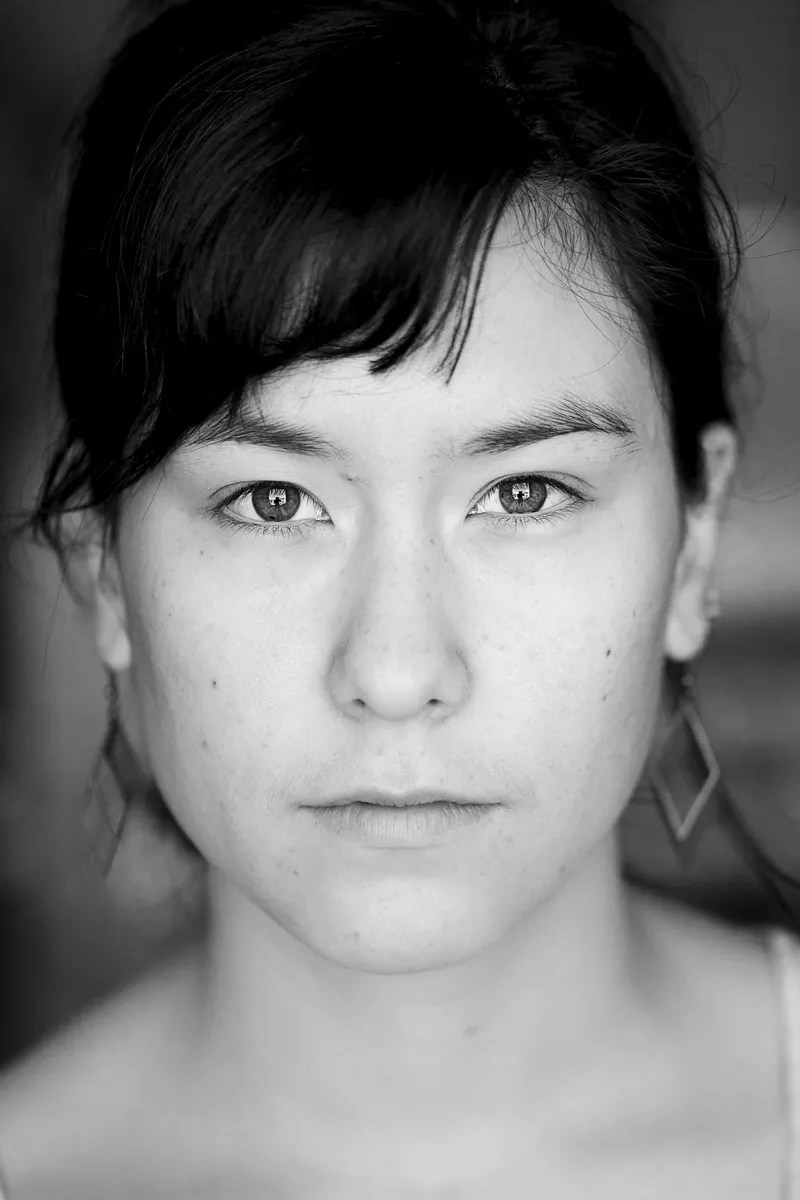
Matthew Staver

Audio By Carbonatix
It’s easy to create a false dichotomy between fine art and design, between form and function or even between art and science. But for Denver-based furniture and object designer Laura Kishimoto, it is the intersection and overlap of these worlds that allow her to create her bold, dramatic and beautifully organic pieces.
“I’m always looking for something that looks like it could have just appeared out of thin air,” she says, “so it doesn’t necessarily look like it was made, [but that] it just formed.” This is certainly the case for her iconic “Yumi Chair,” now a part of the permanent collection at the Denver Art Museum‘s newly renovated Martin building.

“Yumi Chair III” side view.
Matthew Staver
Kishimoto’s path to becoming a furniture designer was as organic as her creative process – unfolding gradually, naturally, and not without its own challenges. Growing up outside of Boston in a family of scientists, she always figured she would go to school for something more “certain.” But her creativity was undeniable from a young age and was recognized by her dad, a microbiologist with interests in photography and whittling. As a first-generation Japanese American, he embodied the John Adams quote that “I must study politics and war that my sons may have liberty to study mathematics and philosophy.”
Will you step up to support Westword this year?
We’re aiming to raise $50,000 by December 31, so we can continue covering what matters most to this community. If Westword matters to you, please take action and contribute today, so when news happens, our reporters can be there.
Kishimoto attended the Rhode Island School of Design, which gives students the opportunity to explore drawing as well as 2D and 3D design during their first year. Although she had the talent for drawing, she recalls feeling a bit restrained by having to keep everything to a single point of view. “When I got in, it was the first time I had been exposed to any three-dimensional work,” she says. “And to me, because you’re kind of considering every viewpoint as a new composition of the object, it was easier to work more abstractly and not as literally.”
She remembers one of her first projects was a small balsa-wood sculpture that formed a perfect square – but only when viewed from above. “My professor was like, ‘That’s intention!'” Kishimoto recalls. “I always thought that you had to be very overt. It was the first time I realized that your intention as an artist doesn’t have to be the interpretation people take away from the object.”
She considered pursuing sculpture as her major, but felt that any time she tried to do something purely sculptural it would lose focus. When she found her way into woodworking, furniture design emerged as the perfect balance between individual artistic expression and the use of rigid, technical skills.

Laura Kishimoto
Mark Woolcott
“You can kind of consider furniture to almost be like an archetype, because almost everyone recognizes a chair, almost everyone recognizes a table,’ she says. “And then if you build off of that archetype that everyone knows, you’re automatically letting them into your thought process a little bit.”
That approach has enabled Kishimoto to explore the balance between design and fine art. She believes that good design is intuitive, and through interaction, you should be able to figure out how an object is supposed to work. Fine art, on the other hand, is more emotional; it’s about inspiring somebody to create their own narrative and build a relationship with the object. “But they overlap a lot,” she adds. “Even my dad would say that there’s a lot of fine art and design elements in science. You can’t just be rigid; otherwise it would never progress.
“I also believe that you should always play to your strengths. And my strengths have never been making a comfortable chair. My first-ever woodworking project was a table that had this woven surface on the top that was concave, and you place something on the table and it would roll into the center and fall through,” she laughs. “I was mostly fixated on that negative space that draws you in and creates a sense of dominance and directs where your eye should be following. It never even occurred to me that you would put stuff on the table.”
This is just one of Kishimoto’s many creative explorations of the intersection between form and function. “It’s a piece of art inspired by a table,” she explains.
After graduating with her BFA, Kishimoto traveled to Ireland for a year to work as an intern for one of her favorite designers, Joseph Walsh Studio. She worked alongside the makers in the workshop, refining her craftsmanship, technique and relationship to her materials. However, there wasn’t a lot of overlap between the designers and the makers, and she realized that designing was a much bigger part of her identity than she had anticipated. “I felt like I wasn’t able to really show my strengths while I was there,” she says.
Living in a remote town outside of Cork presented other challenges, too. “It was considered the sunniest part of Ireland, which means it rains 300 days out of the year,” Kishimoto says. She struggled with her mental health and work-life balance, and among a team of all-male employees in the workshop, she also realized how important it was to have female connections in her life. All of these factors are what led her to Colorado, where she traded the cold and rain for 300 days of sunshine and was able to create a schedule of her own between working as a woodworking contractor, helping a friend with his contract work, and creating her own on-spec work to put into shows.
She also began teaching in the woodshop at Red Rocks Community College, where she continues to teach today, and where she is able to use her position to empower her female students in a traditionally male-dominated discipline. “You often have to give them permission to take up space,” she notes. “They’ll be really nervous, doubting themselves and doubting their right to be there. You have to be like, ‘No, you’re supposed to be here! Go try that thing! I know it’s scary, but just go try it.'”
One of her first spec pieces after she moved to Colorado was “Yumi Chair II,” a second rendition of the original prototype that she created while at RISD. It went to a show in Philadelphia called Making a Seat at the Table: Women Transform Woodworking, which was the first women-only woodworking show since the 1970s. “It was both very moving but very depressing that I knew like half the people in that show; or had heard of them or had some distant connection to them,” Kishimoto says. “But I was also constantly about to cry the entire time, just seeing how women had created various identities for themselves in woodworking.” She recalls her experience in Ireland again: “Working in those environments that were mostly male or mostly white has definitely made me embrace my identity a lot more.”
“Yumi Chair II” continued on to a show in New York, where it was bought privately, and has since made its way to the Mint Museum in North Carolina, where it resides in the Craft + Design permanent collection. Kishimoto has continued showing her work at various shows across the country and in Denver, but one of the most memorable was the Denver Art Museum’s Design After Dark, where she first met Darrin Alfred, the curator of architecture and design at the DAM. He’d had his eye on “Yumi Chair” since it sold in New York, and in 2019 the museum commissioned her to create another one.

It may be art, but you can still sit in the “Yumi Chair.”
Matthew Staver
It is the perfect example of fine art meets design – a piece of art that is integrated with the human form. “I wanted to make it so big so that when somebody sat in it, it actually enhanced the design and kind of created a new element,” Kishimoto explains. “It kind of gives you an avenging angel-of-death look.” The chair she made for the DAM is her fourth and final iteration, and she says it “is by far the best in terms of craftsmanship.” It is currently on display in the DAM’s By Design: Stories and Ideas Behind Objects exhibit.
“A lot of times I like to let my work speak for itself,” Kishimoto concludes. “My work makes me feel empowered. It makes me feel bold and unapologetic and over the top, even though I wouldn’t say that I’m a bold person.”
To learn more about Laura Kishimoto, visit kishimotodesign.com.